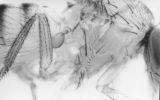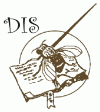      
|


      
|


Busseau, Isabelle and Alain Bucheton. 1999. A Drosophila enhancer detector transposon marked with the yellow gene.
Dros. Inf. Serv. 82: 94-95. View PDF
The P[lyB] enhancer trap vector (Figure 1A) was designed to be used in P-element-mediated mutagenesis and enhancer detection in Drosophila melanogaster. It contains the ß-galactosidase reporter gene and the yellow gene as a transformation and transposition marker. It was derived from P[lAwB] (Flybase ID = FBmc0000173), designed to allow rapid cloning and deletion analysis of genomic sequences into which it inserts, and therefore has retained the same properties.
Construction of the P[lyB] vector and establishment of transgenic lines: P[lyB] was derived from P[lAwB] by replacing the ADH and white sequences from this vector with yellow sequences. The source of the yellow sequences was plasmid Dint (Geyer and Corces, 1987) that contains all DNA sequences from the yellow gene except the intron. The SalI fragment from Dint containing the yellow sequences was first subcloned into the pBluescript KS- vector, in order to place the yellow gene between a XhoI and a XbaI sites. Then the XhoI-XbaI fragment from this clone was ligated to XhoI- and XbaI-cut P[lAwB].
P[lyB] was injected into embryos from the JA strain (carrying both yellow and white mutations) using standard procedures described by Spradling and Rubin (1982) except that puchspD2-3 (Flybase ID: FBmc0002087) was co-injected as the source of transposase. Several independent transgenic lines were established. Two of them, designated J49 and J92, were characterized further by estimating the rates of transposition and excision of P[lyB]. They both carry the P[lyB] transgene on the second chromosome.
Efficient mobilization of P[lyB]: Mobilization of P[lyB] was carried out using P[ry+D2-3](99B) as a stable genomic transposase source, basically using the “jumpstart” scheme of Bellen et al. (1989) modified as shown in Figure 1B. Virgin females from J49 or J92 transgenic line were mated to males homozygous for P[ry+D2-3](99B) and carrying a Cy balancer second chromosome (Figure 2). In the progeny of these crosses, [Cy] males, that carry both P[lyB] and P[ry+D2-3](99B), were selected and mated with virgin females from the JA stock. The occurrence of [y+;Cy] individuals in their progeny reflected transposition events to new chromosomal locations. From these experiments, estimations of transposition frequencies of P[lyB] were 4.7% when using line J49 and 3.3% when using line J92. Although these estimations are rough, because very few flies were scored in these experiments, they indicate that the rate of mobilization of P[lyB] is in the usual range (1-5%) for defective P elements mobilized by P[ry+D2-3](99B) (Engels, 1989). Therefore the P[lyB] element can be used efficiently as an alternative to other enhancer trap elements in cases where the use of a yellow marker appears convenient.
Lines J49 and J92 will be available at the Umea Drosophila Stock Center and at the Bloomington Stock Center. Acknowledgments: We are very grateful to Dr. Walter Gehring for the gift of plasmid P[lAwB] and to Nathalie Rémillieux who participated in these experiments when she was a second year student at the Université Paris XI (Orsay).
 |
Figure 1: A: Sequence organization and partial restriction map of p-lyB. Thick line represents sequences from pBluescript KS-, black boxes represent P element sequences, shaded box represent LacZ sequences, striped box represents yellow sequences. Arrows indicate senses of transcription of LacZ and yellow genes. B: scheme of crosses to estimate the rate of mobilization of p-lyB by P[ry+D2-3](99B) and results. |
References: Bellen, H.J., C.J. O'Kane, C. Wilson, U. Grossniklaus, R.K. Pearson, and W.J. Gehring 1989, Genes Dev. 3: 1288-1300; Geyer, P.M., and V.G. Corces 1987, Genes Dev. 1: 996-1004; Robertson, H.M., C.R. Preston, R.W. Phillis, D.M. Johnson-Schiltz, W.K. Benz., and W.R. Engels 1988, Genetics 118: 461-470; Spradling, A., and G.M. Rubin 1982, Science 218: 341-347; Wilson, C., R.K. Pearson, H.J. Bellen, C.J. O'Kane, U. Grossniklaus, and W.J. Gehring 1989, Genes Dev. 3: 1301-1313.